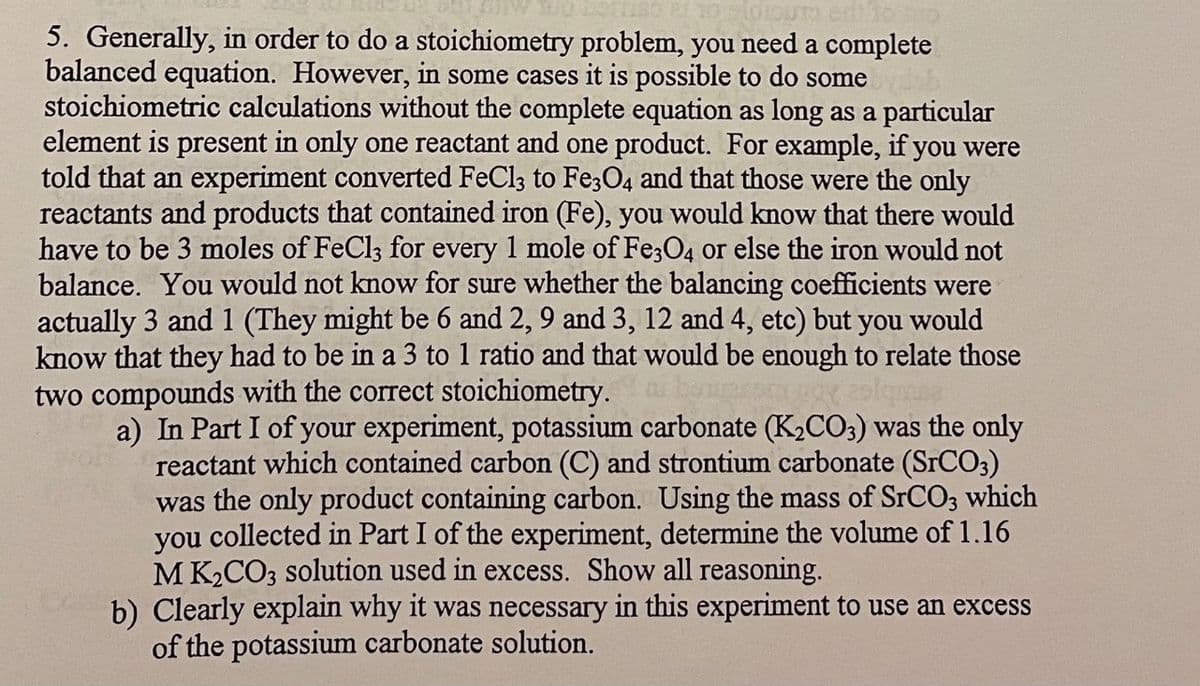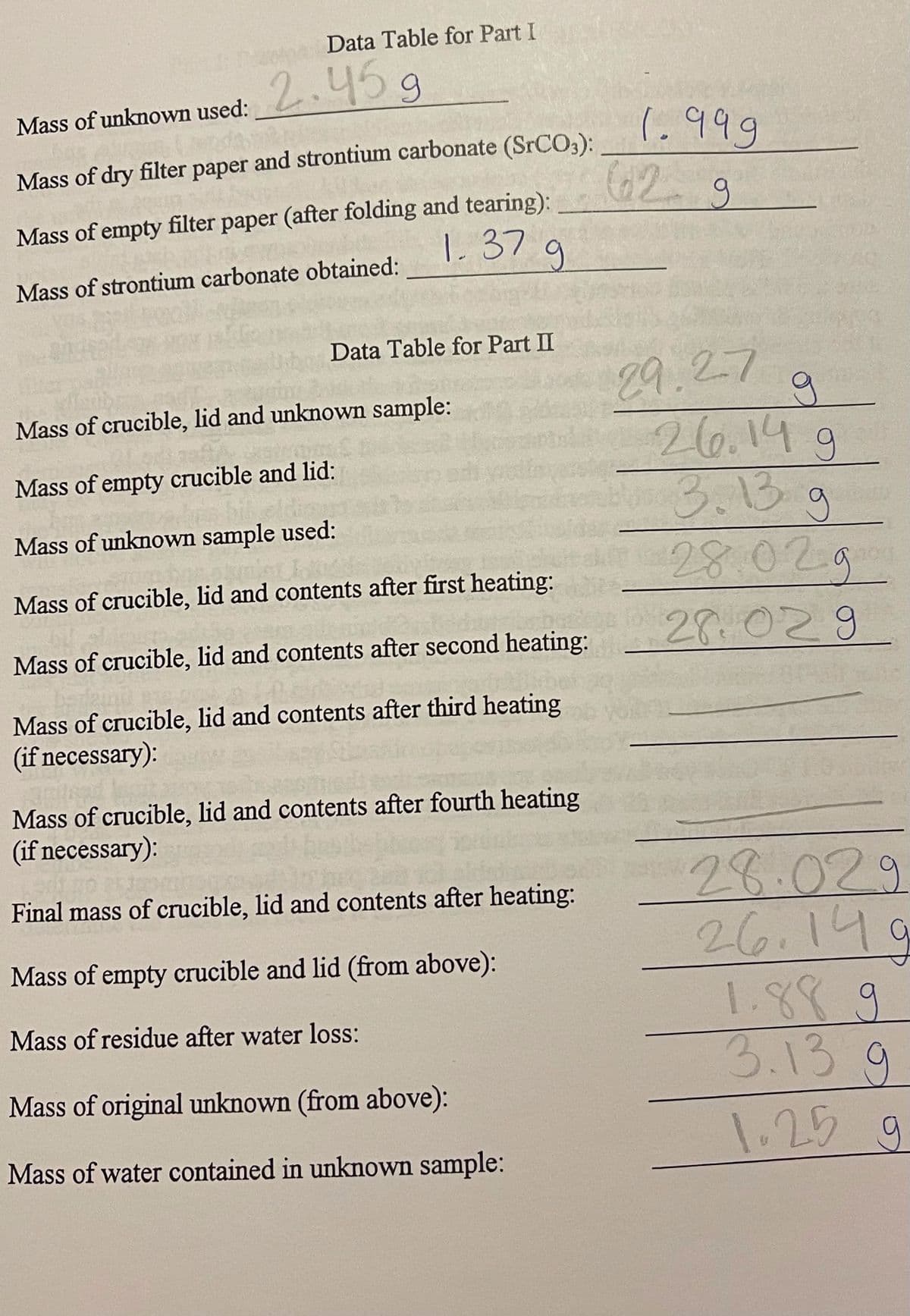5. Generally, in order to do a stoichiometry problem, you need a complete balanced equation. However, in some cases it is possible to do some stoichiometric calculations without the complete equation as long as a particular element is present in only one reactant and one product. For example, if you were told that an experiment converted FeCl3 to Fe;O4 and that those were the only reactants and products that contained iron (Fe), you would know that there would have to be 3 moles of FeCl3 for every 1 mole of Fe;O4 or else the iron would not balance. You would not know for sure whether the balancing coefficients were actually 3 and 1 (They might be 6 and 2, 9 and 3, 12 and 4, etc) but you would know that they had to be in a 3 to 1 ratio and that would be enough to relate those two compounds with the correct stoichiometry. a) In Part I of your experiment, potassium carbonate (K2CO3) was the only reactant which contained carbon (C) and strontium carbonate (SICO3) was the only product containing carbon. Using the mass of STCO3 which you collected in Part I of the experiment, determine the volume of 1.16 M K2CO3 solution used in excess. Show all reasoning. b) Clearly explain why it was necessary in this experiment to use an excess of the potassium carbonate solution.
5. Generally, in order to do a stoichiometry problem, you need a complete balanced equation. However, in some cases it is possible to do some stoichiometric calculations without the complete equation as long as a particular element is present in only one reactant and one product. For example, if you were told that an experiment converted FeCl3 to Fe;O4 and that those were the only reactants and products that contained iron (Fe), you would know that there would have to be 3 moles of FeCl3 for every 1 mole of Fe;O4 or else the iron would not balance. You would not know for sure whether the balancing coefficients were actually 3 and 1 (They might be 6 and 2, 9 and 3, 12 and 4, etc) but you would know that they had to be in a 3 to 1 ratio and that would be enough to relate those two compounds with the correct stoichiometry. a) In Part I of your experiment, potassium carbonate (K2CO3) was the only reactant which contained carbon (C) and strontium carbonate (SICO3) was the only product containing carbon. Using the mass of STCO3 which you collected in Part I of the experiment, determine the volume of 1.16 M K2CO3 solution used in excess. Show all reasoning. b) Clearly explain why it was necessary in this experiment to use an excess of the potassium carbonate solution.
General Chemistry - Standalone book (MindTap Course List)
11th Edition
ISBN:9781305580343
Author:Steven D. Gammon, Ebbing, Darrell Ebbing, Steven D., Darrell; Gammon, Darrell Ebbing; Steven D. Gammon, Darrell D.; Gammon, Ebbing; Steven D. Gammon; Darrell
Publisher:Steven D. Gammon, Ebbing, Darrell Ebbing, Steven D., Darrell; Gammon, Darrell Ebbing; Steven D. Gammon, Darrell D.; Gammon, Ebbing; Steven D. Gammon; Darrell
Chapter3: Calculations With Chemical Formulas And Equaitons
Section: Chapter Questions
Problem 3.141QP: A power plant is driven by the combustion of a complex fossil fuel having the formula C11H7S. Assume...
Related questions
Question

Transcribed Image Text:5. Generally, in order to do a stoichiometry problem, you need a complete
balanced equation. However, in some cases it is possible to do some
stoichiometric calculations without the complete equation as long as a particular
element is present in only one reactant and one product. For example, if you were
told that an experiment converted FeCl3 to Fe3O4 and that those were the only
reactants and products that contained iron (Fe), you would know that there would
have to be 3 moles of FeCl3 for every 1 mole of Fe;O4 or else the iron would not
balance. You would not know for sure whether the balancing coefficients were
actually 3 and 1 (They might be 6 and 2, 9 and 3, 12 and 4, etc) but you would
know that they had to be in a 3 to 1 ratio and that would be enough to relate those
two compounds with the correct stoichiometry.
a) In Part I of your experiment, potassium carbonate (K,CO3) was the only
reactant which contained carbon (C) and strontium carbonate (SrCO3)
was the only product containing carbon. Using the mass of SRCO; which
collected in Part I of the experiment, determine the volume of 1.16
M K2CO3 solution used in excess. Show all reasoning.
b) Clearly explain why it was necessary in this experiment to use an excess
you
of the potassium carbonate solution.

Transcribed Image Text:Data Table for Part I
Mass of unknown used: 2.45g
(. ११५
(629
Mass of dry filter paper and strontium carbonate (SRCO3):
Mass of empty filter paper (after folding and tearing):
1.37 g
9.
Mass of strontium carbonate obtained:
Data Table for Part II
29.27
26.14g
3.13g
28.02g
Mass of crucible, lid and unknown sample:
Mass of empty crucible and lid:
Mass of unknown sample used:
Mass of crucible, lid and contents after first heating:
28.029
Mass of crucible, lid and contents after second heating:
Mass of crucible, lid and contents after third heating
(if necessary):
Mass of crucible, lid and contents after fourth heating
(if necessary):
28.029
26.149
Final mass of crucible, lid and contents after heating:
Mass of empty crucible and lid (from above):
1.88.9
3.139
Mass of residue after water loss:
Mass of original unknown (from above):
Mass of water contained in unknown sample:
Expert Solution
This question has been solved!
Explore an expertly crafted, step-by-step solution for a thorough understanding of key concepts.
This is a popular solution!
Trending now
This is a popular solution!
Step by step
Solved in 3 steps

Knowledge Booster
Learn more about
Need a deep-dive on the concept behind this application? Look no further. Learn more about this topic, chemistry and related others by exploring similar questions and additional content below.Recommended textbooks for you

General Chemistry - Standalone book (MindTap Cour…
Chemistry
ISBN:
9781305580343
Author:
Steven D. Gammon, Ebbing, Darrell Ebbing, Steven D., Darrell; Gammon, Darrell Ebbing; Steven D. Gammon, Darrell D.; Gammon, Ebbing; Steven D. Gammon; Darrell
Publisher:
Cengage Learning

Chemistry for Engineering Students
Chemistry
ISBN:
9781337398909
Author:
Lawrence S. Brown, Tom Holme
Publisher:
Cengage Learning

Chemistry for Engineering Students
Chemistry
ISBN:
9781285199023
Author:
Lawrence S. Brown, Tom Holme
Publisher:
Cengage Learning

General Chemistry - Standalone book (MindTap Cour…
Chemistry
ISBN:
9781305580343
Author:
Steven D. Gammon, Ebbing, Darrell Ebbing, Steven D., Darrell; Gammon, Darrell Ebbing; Steven D. Gammon, Darrell D.; Gammon, Ebbing; Steven D. Gammon; Darrell
Publisher:
Cengage Learning

Chemistry for Engineering Students
Chemistry
ISBN:
9781337398909
Author:
Lawrence S. Brown, Tom Holme
Publisher:
Cengage Learning

Chemistry for Engineering Students
Chemistry
ISBN:
9781285199023
Author:
Lawrence S. Brown, Tom Holme
Publisher:
Cengage Learning

Chemistry: The Molecular Science
Chemistry
ISBN:
9781285199047
Author:
John W. Moore, Conrad L. Stanitski
Publisher:
Cengage Learning

Chemistry: An Atoms First Approach
Chemistry
ISBN:
9781305079243
Author:
Steven S. Zumdahl, Susan A. Zumdahl
Publisher:
Cengage Learning

Chemistry
Chemistry
ISBN:
9781305957404
Author:
Steven S. Zumdahl, Susan A. Zumdahl, Donald J. DeCoste
Publisher:
Cengage Learning